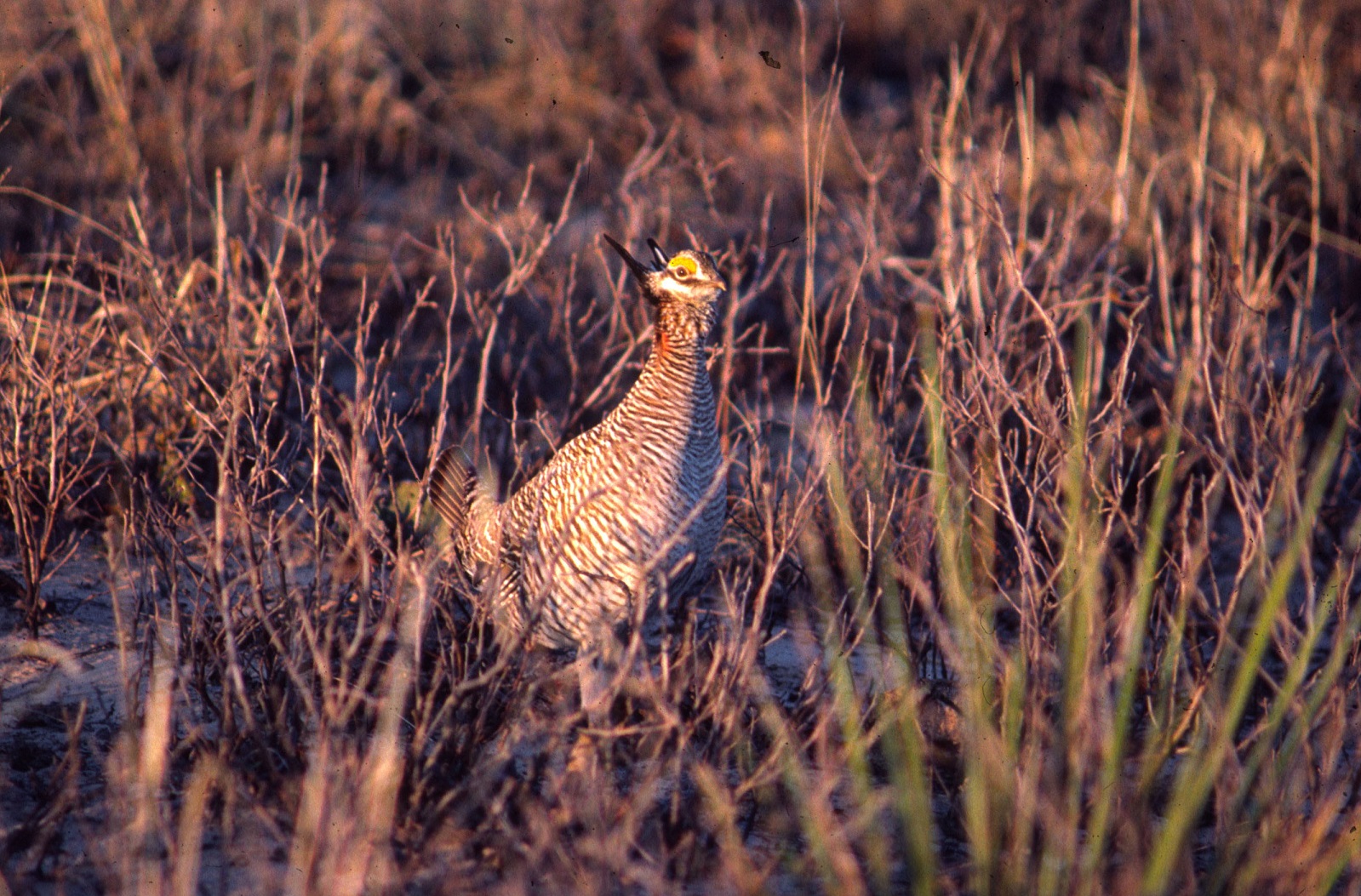Reproductive Success of and Response to Shrub Removal by Lesser Prairie-Chickens in Western Kansas and Eastern Colorado

Joseph Lautenbach, M.S. Student
Project Supervisor:
Dr. David Haukos
Dr. Christian Hagen
Jim Pitman
Funding:
Kansas Department of Wildlife, Parks and Tourism
Colorado Department of Wildlife and Parks
U.S. Fish and Wildlife Service
NRCS USDA
FSA USDA
U.S. Geological Survey
Great Plains LCC
Cooperators:
Jeff Prendergast
TNC
Kansas State University
Location:
Throughout Kansas and eastern Colorado
Completion:
December 2014
Status:
Completed
Objectives:
Investigate the nesting ecology of LEPCs in Kansas and eastern Colorado by measuring nesting propensity, nest site selection, nest site vegetation variables, and nest survival.
Evaluate the relative influence of variables affecting LEPC brood habitat use and survival.
Measure the LEPC response to the removal of woody vegetation (eastern red cedar).
Progress and Results:
The lesser prairie-chicken (Tympanuchus pallidicinctus) is a species of prairie grouse native to the southwest Great Plains. Population declines and threats to populations of lesser prairie-chickens led U.S. Fish and Wildlife Service to list the species as "threatened" under the protection of the Endangered Species Act in May 2014. Lesser prairie-chickens are found within three distinct ecoregions of Kansas and Colorado and portions of the species' range are affected by tree encroachment into grasslands. The effect of trees on lesser prairie-chickens is poorly understood. I evaluated habitat selection and reproductive success and across the northern portion of the species' range. I captured female lesser prairie-chickens within the three different ecoregions in Kansas and Colorado to track nest and brood survival and measure nest and brood habitat. My findings show that there are regional and annual variations in nest and brood survival. Mean nest survival during 2013 and 2014 was estimated to be 0.388 (95% CI = 0.343 - 0.433) for a 35-day exposure period. Brood survival during 2013 and 2014 was estimated to be 0.316 (95% CI = 0.184 - 0.457) for 56 days. Chick survival was the lowest during the first week of life and is probably a limiting factor for population growth. Chick and brood survival decreased as Julian hatch date increased. Across the northern portion of the species' range, females consistently select visual obstruction between 2-3 dm. Vegetation at the nest changes between regions and years to reflect environmental and regional conditions. Broods consistently selected habitats with greater percent cover of forbs than was expected at random across all study sites. Broods also selected against areas of bare ground. The threshold of lesser prairie-chicken use was 2 trees/ha throughout the year. No nests were located within areas with greater densities. Lesser prairie-chickens had a greater probability of use at greater distances from trees and at lower tree densities. To provide adequate nesting habitat managers should provide 2-3 dm of visual obstruction. Providing forb cover with visual obstruction between 2.5-5 dm near nesting areas should provide adequate habitat for broods. Removing trees in core habitats and expand removal efforts outward should expand potential habitat for lesser prairie-chickens.
Products:
Publications
Lautenbach, J.M., R.T. Plumb, S.G. Robinson, D.A. Haukos, J.C. Pitman, and C.A. Hagen. 2017. Lesser prairie-chicken avoidance of trees in a grassland landscape. Rangeland Ecology and Management 70:78-86
Thesis:
Lautenbach, Joseph (M.S., 2015; advisor Haukos) Lesser Prairie-Chicken Reproductive Success, Habitat Selection, and Response to trees. M.S. Thesis, Kansas State University.
Professional Presentations:
Lautenbach, Joseph. 2017. Lesser Prairie-Chicken Avoidance of Trees in a Grassland Landscape. Society for Range Management Meeting in St. George, UT.
Lautenbach, J. R. Plumb, D. Haukos, J. Pitman, and C. Hagen. 2016. The impacts of trees on lesser prairie-chickens. Midwest Fish and Wildlife Conference, Grand Rapids, MI.
Lautenbach, J., R. Plumb, D. Haukos, and J. Pitman. 2014. Impacts of tree encroachment on lesser prairie-chickens. Joint meeting of American Ornithologists' Union, Cooper Ornithological Society, and Society of Canadian Ornithologists, Estes Park, Colorado.
Lautenbach, J., R. Plumb, D. Haukos, and J. Pitman. 2014. Survival and habitat selection of lesser prairie-chicken chicks and broods. Joint meeting of American Ornithologists' Union, Cooper Ornithological Society, and Society of Canadian Ornithologists, Estes Park, Colorado.
Lautenbach, J., R. Plumb, D. Haukos, and J. Pitman. 2014. Differences in successful and unsuccessful nests of lesser prairie-chickens in Kansas and Colorado. Kansas Natural Resource Conference, Wichita, Kansas.
Lautenbach, J., R. Plumb, D. Haukos, and J. Pitman. 2014. Nest site location by lesser prairie-chickens in Kansas and Colorado. Midwest Fish and Wildlife Conference, Kansas City, MO.
Lautenbach, J., R. Plumb, D. Haukos, and J. Pitman. 2013. Regional variation in nest success of lesser prairie-chickens in Kansas and Colorado. Biennial meeting of the Prairie Grouse Technical Council, Crookston, MN.
Lautenbach, J., R. Plumb, D. Haukos, and J. Pitman. 2013. Factors affecting brood and chick survival of lesser prairie-chickens in Kansas and Colorado. Biennial meeting of the Prairie Grouse Technical Council, Crookston, MN.